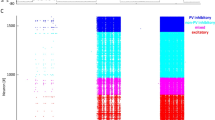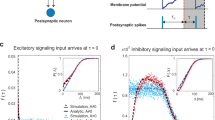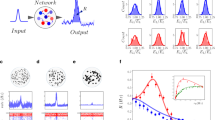Abstract
Recent theoretical work has provided a basic understanding of signal propagation in networks of spiking neurons, but mechanisms for gating and controlling these signals have not been investigated previously. Here we introduce an idea for the gating of multiple signals in cortical networks that combines principles of signal propagation with aspects of balanced networks. Specifically, we studied networks in which incoming excitatory signals are normally cancelled by locally evoked inhibition, leaving the targeted layer unresponsive. Transmission can be gated 'on' by modulating excitatory and inhibitory gains to upset this detailed balance. We illustrate gating through detailed balance in large networks of integrate-and-fire neurons. We show successful gating of multiple signals and study failure modes that produce effects reminiscent of clinically observed pathologies. Provided that the individual signals are detectable, detailed balance has a large capacity for gating multiple signals.
This is a preview of subscription content, access via your institution
Access options
Subscription info for Japanese customers
We have a dedicated website for our Japanese customers. Please go to natureasia.com to subscribe to this journal.
Buy this article
- Purchase on SpringerLink
- Instant access to full article PDF
Prices may be subject to local taxes which are calculated during checkout







Similar content being viewed by others
References
Shu, Y., Hasenstaub, A. & McCormick, D.A. Turning on and off recurrent balanced cortical activity. Nature 423, 288–293 (2003).
Haider, B., Duque, A., Hasenstaub, A.R. & McCormick, D.A. Neocortical network activity in vivo is generated through a dynamic balance of excitation and inhibition. J. Neurosci. 26, 4535–4545 (2006).
Shadlen, M.N. & Newsome, W.T. Noise, neural codes and cortical organization. Curr. Opin. Neurobiol. 4, 569–579 (1994).
Troyer, T.W. & Miller, K.D. Physiological gain leads to high ISI variability in a simple model of a cortical regular spiking cell. Neural Comput. 9, 971–983 (1997).
Amit, D.J. & Brunel, N. Model of global spontaneous activity and local structured activity during delay periods in the cerebral cortex. Cereb. Cortex 7, 237–252 (1997).
van Vreeswijk, C. & Sompolinsky, H. Chaos in neuronal networks with balanced excitatory and inhibitory activity. Science 274, 1724–1726 (1996).
Brunel, N. Dynamics of networks of randomly connected excitatory and inhibitory spiking neurons. J. Physiol. (Paris) 94, 445–463 (2000).
Kumar, A., Schrader, S., Aertsen, A. & Rotter, S. The high-conductance state of cortical networks. Neural Comput. 20, 1–43 (2008).
Abeles, M. Corticonics: Neural Circuits of the Cerebral Cortex (Cambridge University Press, Cambridge, UK, 1991).
Aertsen, A., Diesmann, M. & Gewaltig, M.O. Propagation of synchronous spiking activity in feedforward neural networks. J. Physiol. (Paris) 90, 243–247 (1996).
Diesmann, M., Gewaltig, M.O. & Aertsen, A. Stable propagation of synchronous spiking in cortical neural networks. Nature 402, 529–533 (1999).
van Rossum, M.C., Turrigiano, G.G. & Nelson, S.B. Fast propagation of firing rates through layered networks of noisy neurons. J. Neurosci. 22, 1956–1966 (2002).
Vogels, T.P., Rajan, K. & Abbott, L.F. Neural networks dynamics. Annu. Rev. Neurosci. 28, 357–376 (2005).
Vogels, T.P. & Abbott, L.F. Signal propagation and logic gating in networks of integrate-and-fire neurons. J. Neurosci. 25, 10786–10795 (2005).
Destexhe, A. & Contreras, D. Neuronal computations with stochastic network states. Science 314, 85–90 (2006).
Kumar, A., Rotter, S. & Aertsen, A. Conditions for propagating synchronous spiking and asynchronous firing rates in a cortical network model. J. Neurosci. 28, 5268–5280 (2008).
Posner, M.I. ed. Cognitive Neuroscience of Attention (Guilford Press, New York, 2004).
Germuska, M., Saha, S., Fiala, J. & Barbas, H. Synaptic distinction of laminar-specific prefrontal-temporal pathways in primates. Cereb. Cortex 16, 865–875 (2006).
Salinas, E. Context-dependent selection of visuomotor maps. BMC Neurosci. 5, 47–68 (2004).
Disney, A.A., Aoki, C. & Hawken, M.J. Gain modulation by nicotine in macaque v1. Neuron 56, 701–713 (2007).
Disney, A.A. & Aoki, C. Muscarinic acetylcholine receptors in macaque V1 are most frequently expressed by parvalbumin-immunoreactive neurons. J. Comp. Neurol. 507, 1748–1762 (2008).
Disney, A.A., Domakonda, K.V. & Aoki, C. Differential expression of muscarinic acetylcholine receptors across excitatory and inhibitory cells in visual cortical areas V1 and V2 of the macaque monkey. J. Comp. Neurol. 499, 49–63 (2006).
Xiang, Z., Huguenard, J.R. & Prince, D.A. Cholinergic switching within neocortical inhibitory networks. Science 281, 985–988 (1998).
Gil, Z., Connors, B.W. & Amitai, Y. Differential regulation of neocortical synapses by neuromodulators and activity. Neuron 19, 679–686 (1997).
Mitchell, J.F., Sundberg, K.A. & Reynolds, J.H. Differential attention-dependent response modulation across cell classes in macaque visual area V4. Neuron 55, 131–141 (2007).
Binzegger, T., Douglas, R.J. & Martin, K.A. A quantitative map of the circuit of cat primary visual cortex. J. Neurosci. 24, 8441–8453 (2004).
Abbott, L.F. Theoretical neuroscience rising. Neuron 60, 489–495 (2008).
Anderson, C.H. & Van Essen, D.C. Shifter circuits: a computational strategy for dynamic aspects of visual processing. Proc. Natl. Acad. Sci. USA 84, 6297–6301 (1987).
Olshausen, B.A., Anderson, C.H. & Van Essen, D.C. A neurobiological model of visual attention and invariant pattern recognition based on dynamical routing of information. J. Neurosci. 13, 4700–4719 (1993).
Pouille, F. & Scanziani, M. Routing of spike series by dynamic circuits in the hippocampus. Nature 429, 717–723 (2004).
Okun, M. & Lampl, I. Instantaneous correlation of excitation and inhibition during ongoing and sensory-evoked activities. Nat. Neurosci. 11, 535–537 (2008).
Baca, S.M., Marin-Burgin, A., Wagenaar, D.A. & Kristan, W.B. Jr. Widespread inhibition proportional to excitation controls the gain of a leech behavioral circuit. Neuron 57, 276–289 (2008).
Song, S., Miller, K.D. & Abbott, L.F. Competitive Hebbian learning through spike-timing dependent synaptic plasticity. Nat. Neurosci. 3, 919–926 (2000).
Morrison, A., Aertsen, A. & Diesmann, M. Spike-timing-dependent plasticity in balanced random networks. Neural Comput. 19, 1437–1467 (2007).
Lewis, D.A., Hashimoto, T. & Volk, D.W. Cortical inhibitory neurons and schizophrenia. Nat. Rev. Neurosci. 6, 312–324 (2005).
Seeman, P. Dopamine receptors and the dopamine hypothesis of schizophrenia. Synapse 1, 133–152 (1987).
Moore, H., West, A.R. & Grace, A.A. The regulation of forebrain dopamine transmission: relevance to the pathophysiology and psychopathology of schizophrenia. Biol. Psychiatry 46, 40–55 (1999).
Tamminga, C.A. Schizophrenia and glutamatergic transmission. Crit. Rev. Neurobiol. 12, 21–36 (1998).
Jackson, M.E., Homayoun, H. & Moghaddam, B. NMDA receptor hypofunction produces concomitant firing rate potentiation and burst activity reduction in the prefrontal cortex. Proc. Natl. Acad. Sci. USA 101, 8467–8472 (2004).
Rubenstein, J.L. & Merzenich, M.M. Model of autism: increased ratio of excitation/inhibition in key neural systems. Genes Brain Behav. 2, 255–267 (2003).
Tabuchi, K. et al. A neuroligin-3 mutation implicated in autism increases inhibitory synaptic transmission in mice. Science 318, 71–76 (2007).
Aviel, Y., Mehring, C., Abeles, M. & Horn, D. On embedding synfire chains in a balanced network. Neural Comput. 15, 1321–1340 (2003).
Acknowledgements
The idea of detailed balance was originally suggested to us by G. Turrigiano. Research supported by the US National Science Foundation (IBN-0235463), the Swartz Foundation, the Patterson Trust Fellowship Program in Brain Circuitry and a US National Institutes of Health (NIH) Director's Pioneer Award, part of the NIH Roadmap for Medical Research, through grant number 5-DP1-OD114-02. Thanks to J. Peelle, M. Schiff, P. Jercog and R. Yuste for suggestions.
Author information
Authors and Affiliations
Corresponding author
Rights and permissions
About this article
Cite this article
Vogels, T., Abbott, L. Gating multiple signals through detailed balance of excitation and inhibition in spiking networks. Nat Neurosci 12, 483–491 (2009). https://doi.org/10.1038/nn.2276
Received:
Accepted:
Published:
Issue Date:
DOI: https://doi.org/10.1038/nn.2276



